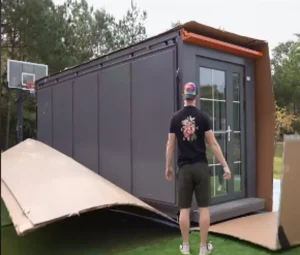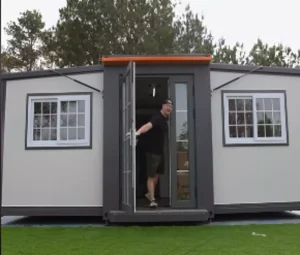With every passing year, it becomes increasingly challenging to get a foot on the property ladder. The dream of homeownership seems to slip further away, particularly for younger generations and first-time buyers. The stark reality of today’s housing market is starkly illustrated when individuals find themselves bidding for rented flats, competing against other desperate house hunters just to secure a roof over their heads. This predicament signals a serious issue in the housing landscape, where demand far outstrips supply, pushing prices to exorbitant heights.
In the midst of this turmoil, most people might not consider a tech giant like Amazon as a viable option for real estate. While many view Amazon as a vast digital warehouse brimming with an array of products—from the mundane to the bizarre—few would think of it as an estate agent. However, a curious individual recently decided to explore this unconventional avenue when he stumbled upon a ‘tiny house’ for sale on the platform.

The rising costs of housing have catalyzed a shift in how many view living spaces, leading to the increasing popularity of tiny living. As housing prices soar, many are opting to downsize their living arrangements, seeking out smaller, more affordable homes that allow them to manage their finances better without sacrificing comfort. This trend has paved the way for a range of retailers to offer tiny homes, and now, it seems Amazon has also entered the fray, providing an array of options for those looking to minimize their living space.
One notable case involves TikTok user Nathan Graham, who goes by the handle @unspeakable_fanytb. After coming across one of these tiny homes for sale on Amazon, Graham took the plunge and ordered one, documenting the entire experience for his followers. His video, which quickly went viral, garnered over 21 million views and captured the imagination of countless viewers.
In the footage, Graham showcases the pre-built home, measuring a modest 19 feet by 20 feet, which he purchased for just £15,000 (approximately $20,000). The process begins with Graham ordering the tiny house through Amazon, followed by its delivery to his garden—a moment filled with anticipation and curiosity. Upon arrival, he excitedly removes the packaging, opens the door, and steps inside, highlighting that tiny homes are essentially ready for use right out of the box. This revelation is both incredible and, perhaps, a bit depressing, emphasizing the gap between what many desire in a home and what is actually attainable.

Inside the compact house, viewers can see a hallway and a bathroom that are already set up. The rest of the living space requires some assembly, which Graham and his friends tackle with enthusiasm. The assembly process is surprisingly straightforward, involving folding out sections and slotting them into place. Once fully put together, the tiny home expands, revealing two additional spaces that enhance its usability.
The compact house comes equipped with essential facilities, including plumbing connections, which is a significant advantage for anyone considering tiny living. There’s also ample room for adding furniture, allowing for personalization and comfort. However, it’s important to note that the house does not come with electrical wiring, meaning this is an additional task that must be completed after purchase—preferably by a qualified professional.
Graham’s video sparked a lively discussion among TikTok users, many of whom were astonished by the concept of buying a home through Amazon. Comments ranged from enthusiasm to practical inquiries, reflecting the varied reactions to this unconventional approach to housing. One user simply declared, “Worth it,” clearly impressed by the affordable price and innovative idea. Another chimed in with a practical thought, stating, “I actually think this is cool; it would be easy to get land somewhere and put this up and live decently.” This comment underscores the appeal of tiny living as a potential solution to the housing crisis for those who can find suitable land.
However, the video also raised questions about the logistics of tiny living. One viewer posed a particularly poignant question: “What address do you ship it to if you don’t have a house?” This inquiry highlights the complexities of housing today; even innovative solutions like tiny homes cannot address the fundamental issue of land access.
As the housing crisis continues to unfold, the tiny home trend may offer a glimmer of hope for those feeling overwhelmed by soaring property prices. For some, these compact spaces represent a pragmatic way to escape the rental rat race and reclaim some level of financial independence. With options now available through unconventional avenues like Amazon, the idea of homeownership, albeit in a much smaller form, may become more attainable for those willing to embrace a minimalist lifestyle.
In conclusion, Nathan Graham’s viral TikTok video serves as a fascinating case study in the evolving landscape of housing and the creative solutions individuals are exploring in response to economic pressures. As more people seek alternative living arrangements, the tiny house trend exemplifies a growing movement towards simplicity and affordability. While the challenges of the housing market are daunting, innovations like these could provide a much-needed lifeline for those striving to find their place in an increasingly complex world. Whether it’s on TikTok or in everyday life, the conversation around tiny living is likely to continue, offering both inspiration and practical solutions for a generation facing unprecedented housing challenges.





